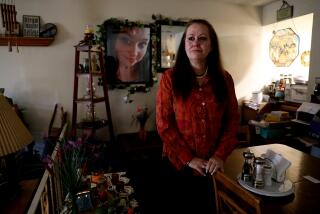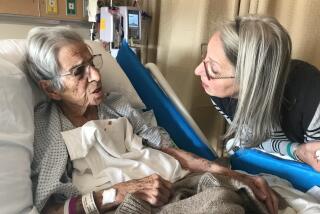Nurse Says She’ll Be Cleared in ‘Angel of Death’ Inquiry : Medicine: Darlene Leon was never formally charged in 17 hospice deaths. Officials say probe is continuing.
- Share via
BANNING, Calif. — During her six months as a hospice nurse, mustering all the compassion she could in offering aid and comfort to dying patients and their families, Darlene Leon was given the nickname “Angel of Death” by a co-worker. She thought it distasteful, but reluctantly accepted the term as an endearment.
But the connotation turned ugly after one of her fellow nurses went to authorities--and then to a Los Angeles television station--and accused Leon of having killed as many as 17 of her patients with lethal doses of morphine.
Leon said she did not even know of the investigation until confronted May 10 by a television news reporter, and she has been reeling ever since from the publicity, the headlines and her unwitting appearance on the evening news.
“Oh look, there’s the woman who killed 17 people,” a woman in a grocery line coolly remarked one recent day, freezing Leon in her tracks. At an automated teller machine, the person behind Leon wisecracked, “Withdrawing your death money?”
San Bernardino County sheriff’s homicide detectives offer only statements that the investigation is continuing. But the San Bernardino County coroner’s office, after a toxicology examination of one of Leon’s disinterred patients, announced June 1 that the man died of an overdose of codeine and morphine and amended the man’s death certificate to indicate that he did not die of natural causes, as previously assumed. Still unclear is whether his death was a homicide, suicide or accident.
The coroner said he would conduct toxicology tests on other disinterred bodies and has not yet released findings.
Leon’s detractors--though not speaking for the record--said the toxicology findings vindicate their decision to air the allegations.
But Leon said she voluntarily took--and passed--a polygraph examination Friday and was told by investigators that she is now on the brink of being cleared of any wrongdoing in a case where she has never been formally charged.
Sheriff’s deputies confirmed that Leon took a polygraph exam but would not discuss the results. Deputy Sheriff Laurie Savage said, “The case is proceeding; it’s still active. But like we said before, based on the evidence there’s nothing to show that she has committed any crime. We are awaiting the results from the coroner’s office.”
On Wednesday, freed by her attorney to discuss the case and sounding confident that she will be cleared, Leon wondered if she will ever shed the reputation as a mass-murdering nurse, the Angel of Death.
“Nurses are the most vicious and vindictive people there are,” she said of the two former co-workers she believes sparked the investigation. “And I’d like to ask them, ‘Why? Why do you feel I’d do something like that?’ ”
Then Leon said she would like to resume her nursing career, one that has lasted off and on for more than 22 years. Leon said her most recent employer told her she could not work until the dust settles. Patients would wonder, her boss said. She said she was told she would be working again as soon as her name was cleared.
“And then I’ll be able to go back to work, to help people,” said the 49-year-old divorcee, who lives in a small home with her grown daughter and her grandchildren. The place is heavily accented with American Indian paintings and crafts that reflect her half-Apache ancestry.
Leon said she spent most of her nursing career as a director of nurses, jumping from one job to the next as a trouble-shooter to help various nursing homes and convalescent care facilities pass license inspections. She said she would go in, fix up the place and move to the next task.
She was hired by the Pomona-San Bernardino Visiting Nurses Assn. in January, 1992, and that summer “they told me, ‘You are now a hospice nurse.’ ”
“I had no experience in that,” she said. The training amounted to viewing a video, reading a manual of medical and legal guidelines, and shadowing another hospice nurse for a week, she said. Then she started out on her own, ultimately building a caseload of 60 patients--some in their own homes, some in nursing care facilities, she said.
She made the adjustment from a nursing manager to a hospice nurse, and soon enough was bonding with her patients and their families. She recalls that 30 or 35 died while under her care. Some died soon after she took their cases; others had been alive for six months or longer when she was fired by the company in February after a co-worker alleged that drugs were missing at a patient’s home, according to Leon.
She said the drugs had been misplaced by the family and later found.
Meanwhile, Leon landed another nursing job. She says she has no idea why she is accused of causing even one death--or 17.
She learned of the accusations, she said, when a KNBC Channel 4 reporter asked to interview her about hospice care. “I thought it was going to be a little community news thing,” she said. She hurried home and willingly talked of her profession, she said, when the newsman launched the broadside: So, do you know you’re accused of killing 17 patients?
“I couldn’t believe what I was hearing,” she said. She watched herself on the news that night.
The next day, her cul-de-sac was filled with video cameras and reporters hoping to talk to the Angel of Death.
The crux of the investigation, she said, is whether she administered overdoses of morphine. The fact is, she said, she never gave medicine, period. Typically in hospice care, the in-home care-givers or relatives are charged with administering painkillers.
“You instruct the family on how to do it, you leave it with them and you monitor its usage. . . . I’d only see them three days a week, to assess their condition on behalf of the doctor, answer questions, offer support.”
She said she wholly endorses the hospice philosophy, in which terminally ill patients reject further medical treatment and choose, typically, to die at home, where medicine is given only to manage the pain.
Has she ever wished she could speed that dying process and more quickly release her patient from pain?
“No. Doctors keep their patients’ pain under control as much as possible. I can’t think of a single patient who, when the pain worsened, the doctor didn’t respond. I never saw a patient suffer.
“A patient will die when he’s ready. He just wants to be pain-free. Death takes its course. I don’t believe in euthanasia and would never be a part of it. I don’t believe I have the right to make the decision on when someone should die.
“There’s a Higher Being than us to make that decision,” she said. “I’m Native American. I don’t believe in interfering with the laws of nature.”
More to Read
Sign up for Essential California
The most important California stories and recommendations in your inbox every morning.
You may occasionally receive promotional content from the Los Angeles Times.













